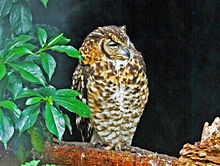Cape eagle-owl
| Cape eagle-owl | |
|---|---|
 |
|
|
Cape eagle-owl hoots, recorded in Transvaal Province, South Africa
|
|
| Scientific classification | |
| Kingdom: | Animalia |
| Phylum: | Chordata |
| Class: | Aves |
| Order: | Strigiformes |
| Family: | Strigidae |
| Genus: | Bubo |
| Species: | B. capensis |
| Binomial name | |
|
Bubo capensis Smith, 1834 |
|
The Cape eagle-owl (Bubo capensis) is a species of owl in the family Strigidae. It is one of several large species of the eagle-owl genus Bubo.
It is found in most of Africa, both north and south of the Sahara, as well as the southwestern Arabian Peninsula. The distribution of the species is widespread, but its range is limited largely to the southern-most regions of southern Africa as well as parts of East Africa.
The Cape eagle-owl is primarily found in mountainous regions or hilly areas with rocks where they find areas to roost, but can also be found in adjacent woodlands, grasslands, and wooded gullies. They are found from sea level up to 2,500 meters above sea level. These owls may also wander into human settlements or even towns, often specifically to predate abundant rock doves.
This is a large owl, though intermediate in size among other large Bubo owls. Its total length ranges from 46 to 61 cm (18 to 24 in). Males weigh from 905 to 1,387 g (1.995 to 3.058 lb) while the larger females range from 1,240 to 1,800 g (2.73 to 3.97 lb). The wing chord measures 34.3–41.8 cm (13.5–16.5 in) while the tail measures 15.5–26.6 cm (6.1–10.5 in). This owl is dark brown above with prominent ear-tufts and yellow or yellowish-orange eyes. It is dark below with the sides of the breast being blotchy brown and the paler chest overlaid with white, black and tawny-fulvous markings, variously. The facial disc is fulvous-brown, with a distinct black or dark brown frame that becomes broader towards the neck. Both the tail and wing feathers are barred with light and dark brown. The toes and tarsi are densely feathered, with the little visible skin being brown above and yellowish below the feet.
The song of the male Cape eagle-owl consists of a powerful, explosive hoot, followed by a faint note: boowh-hu. The female's voice is similar but slightly higher pitched. Pairs on occasion will duet. When approaching a female during courtship, the male will let out a trisyllabic cu-coo-cu while bowing to his mate. Both females and young give a nasal, drawn-out chrrreeh while begging for food at the nest. Females cluck slightly while offering food to their young. When alarmed, both sexes let out a barking wack wack wack....
...
Wikipedia

